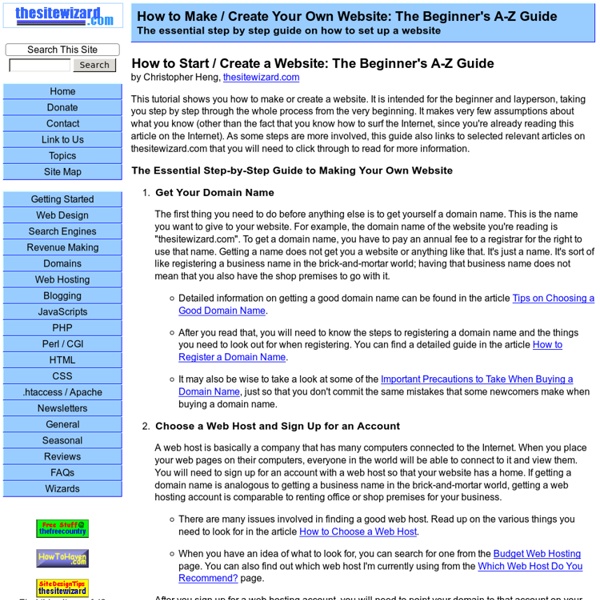Zoom
Trash
Related: Writing



Using WordPress.com to Create a Website With WordPress.com, it’s easy to create your own website or blog in seconds. For definition’s sake, a blog is a type of website that shows the newest content at the top of the page. A blog can also be one part of a website with multiple pages. On WordPress.com, you can choose any of those options, easily adding pages and other goodies to your site, customizing the style and appearance to your needs. Here are some suggestions on how to get started: Find Inspiration Check out our theme showcase for some great examples of all the different blog/website styles that are possible with WordPress.com. ↑ Table of Contents ↑ Create a Home Page With a default blog setup, your front page will display your latest posts. Add More Pages Many blogs have a single page or two, with one for posts and the other for an “About Me” section. If you have a theme that supports Custom Menus, you can: Comments can be a great way to solicit your readers’ feedback, but sometimes you want to keep things super simple.
16 Cheat Sheets on 16 Essential Topics for Web Designers Cheat sheets has several benefits from saving you a lot of time to also helping you improve your skills and productivity in that cetrain task. They provide a great and quick reference and also helps your learn faster by showing all the necessary information needed. There are documentations, but they can sometimes be a hassle. It is pretty hard to remember everything and thankfully, there are cheat sheets. WordPress Template Tags .htaccess jQuery Web Developer’s SEO Photoshop Keyboard Shortcuts MySQL Javascript Color Codes Apache Firebug Ruby on Rails Hopefully that covers every topic a web designer needs to know.
Multimedia Introduction TextFixer.com - Webmaster Online HTML tools for fixing, changing and manipulating text and html. Learn How to Build a Website-Starting Today Mastering CSS, Part 1: Styling Design Elements | CSS Advertisement CSS is one of the most important building blocks of modern web design. Standards demand the use of CSS for formatting and styling pages, and with good reason. And CSS isn’t nearly as tricky as some people tend to believe. 1. CSS is now the primary language used to create page layouts on modern websites. The simplest way to horizontally and vertically center a DIVThis article covers centering a DIV, both vertically and horizontally, using CSS. New CSS Sticky Footer – 2009Here’s a sticky footer technique that’s completely cross-browser compatible. Simple Page Peel Effect with jQuery and CSSThis tutorial combines jQuery and CSS to create a page peel effect. Equal height boxes with CSSHere’s a basic example of creating equal-height boxes (faux columns) using CSS. Adaptable view – how do they do it? CSS: The All-Expandable BoxHere’s a tutorial for creating a CSS box that will expand in all directions to fit the content contained within it, instead of just vertically. 2. 3. 4.
محرر CSS3 - معلم الويب | معلم الويب يوجد الكثير من الأدوات التي تساعدك في تحرير أكواد للغة CSS3، بحيث لا تحتاج منك إلى تذكر تلك الأكواد أو أن تصرف الكثير من الجهد والوقت في الحصول على النتيجة التي تبحث عنها. من الأدوات التي استخدمها دائما في بناء مواقع الويب الأداة css3generator حيث تتميز بالبساطة والسهولة في الإستخدام. أداة تحرير أكواد CSS يمكن من خلال هذه الأداة أن تختار من القائمة الخاصية التي تبحثها عنها. تعليق
How to: Get a website to appear on Google Internal link structure, choosing keywords, indexed pages, XML Sitemaps… it’s all covered in our step-by-step instructions on getting your site to the top of Google search results. Getting your website to appear at the top of the Google search results is arguably the best way to advertise yourself on the internet, and assuming you can put in a bit of time and effort to set your site and content up in the right way, it’s completely free! Getting your pages ‘indexed’ in the Google database requires a few key tasks to be completed. Before you start: You need a Moonfruit site with a few pages of content and/or productsSign up for a Google account if you don’t already have one Now let’s get started Step 1: Make sure all your pages are accessible by navigating through your site and making sure your internal link structure doesn’t have any holes. Step 2: Ensure that every page has a decent amount of relevant text content. Step 6: Submit an XML sitemap to Google. Something else to try:
Fanfic demographics - Google Forms